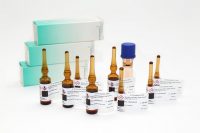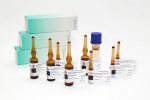A certified reference material (CRM) is generally recognized as providing the highest level of traceability and accuracy to a measurement. A CRM designed specifically for cannabis testing and tailored to state-specific testing regulations could help laboratories better ensure the safety of their products.
The fact that a certificate accompanies a reference material does not qualify it as a CRM. The reference material must be produced in accordance with ISO Guide 34 specifications by an accredited manufacturer. Adam Ross, key account manager and organic specialist at LGC Standards, says accreditation is a big part of bringing legitimacy to cannabis testing. “For a laboratory to receive an ISO 17025 accreditation, they must purchase their RMs from an ISO 17025 manufacturer. The best option is to purchase an ISO Guide 34 manufactured CRM,” says Ross. “It is particularly important for testing requirements, such as potency, pesticides, etc., where quantitation is expected, to use properly certified quantitative reference materials.” LGC Standards, a 175-year-old company, is one of those manufacturers that invested the time and money to achieve ISO Guide 34 accreditation and offers a spectrum of CRMs for cannabis testing.

The major advantage to using a proper CRM is an increased level of credibility. Auditors recognize the value of using a CRM which can add to the integrity of the results produced. The regular use of certified reference standards along with proper training, methodology and instrumentation, will facilitate a result that has the least amount of uncertainty and is more defendable. “The regular use of certified reference standards will help ensure products that go to market are safe to consume,” says Ross.
With regard to potency analyses, Ross has some key insights to help a laboratory better utilize CRMs. “My advice? Don’t mix the cannabinoids; labs analyzing by GC/FID have discovered that some of the cannabinoids will co-elute. Also, they have a short shelf life when mixed together,” says Ross. “Cannabinoid analysts should use GC/MS or LC/MS for their analysis or analyze the cannabinoids individually,” says Ross.
 So what happens if a cannabis lab uses non-certified reference materials? Labs might save money in the short term. CRMs are slightly more expensive than a non-certified reference material, but will increase the defensibility of a lab’s data. Using a reference material created in-house or from a non-accredited vendor can lead to less-than-accurate results. A non-certified reference material has a greater chance of being made incorrectly. The publication of incorrect data damages the credibility of the testing lab and could lead to legal action against the lab from damaged parties.
So what happens if a cannabis lab uses non-certified reference materials? Labs might save money in the short term. CRMs are slightly more expensive than a non-certified reference material, but will increase the defensibility of a lab’s data. Using a reference material created in-house or from a non-accredited vendor can lead to less-than-accurate results. A non-certified reference material has a greater chance of being made incorrectly. The publication of incorrect data damages the credibility of the testing lab and could lead to legal action against the lab from damaged parties.
One of the major challenges for the cannabis testing industry is the variation in state-to-state regulations. Ross says that Oregon’s regulations are pretty comprehensive and that other states should look to the Oregon Environmental Laboratory Accreditation Program (ORELAP) for guidance. According to Ross, ORELAP would like to see higher quality standards with legitimate traceability. Utilizing CRMs the correct way will help laboratories achieve greater accuracy.
Here are some tips for using CRMs appropriately:
- Always bring your standards to room temperature before making a dilution.
- Matrix matched calibration standards provide more accurate quantitation. Prepare standards in the solvent from extracted blank matrices.
- Always bracket your analytical runs with continuing calibration verification standards. Proving that your instrument remained calibrated during the run gives your data more credibility.
Analytical chemists purchase CRMs for three primary uses in the testing lab:
- To calibrate the instrument that will be used to perform the testing
- To confirm the instruments continuing calibration throughout the analytical process
- For analytical quality control or “spikes”
Typically, labs will spike known concentrations of the analytes of interest into a control sample and regular samples with the intent of testing analytical efficiency. Recoveries of analytes from the spiked control sample tell the chemist how well the analytical method is working. The spiked samples (matrix spikes) demonstrate to what extent the sample matrix (the consumable being tested) is influencing the results of the analytical procedure.
CRMs could be described as the nexus between cannabis testing results, the human element and the instrumentation used in an analysis. By using a cannabis-specific CRM, the cannabis testing community can demonstrate tangible improvements in accuracy and legitimacy.




This is a great general article for any body trying to understand chemical quantitative analysis in the context of cannabis product testing, especially for folks who have no previous analytical chemistry experience. I second the main point of this article wholeheartedly: USE CERTIFIED REFERENCE MATERIALS wherever possible and suitable. Unfortunately, quality CRMs aren’t where they need to be for fully normalized cannabis analysis – cannabinoids DEA-limited to only 1 mg per mL? Please….
However, I have a few qualms with points in the article as a practicing cannabis chromatographer with half a dozen validated methods under my belt.
For one, if you have a chromatographic method that doesn’t resolve all analytes, the method isn’t complete. The interview suggestion that standards should be shot one at a time, or must be done with MS detection, only applies when chromatography itself isn’t enough, which is ideally never. We resolve 8 major cannabinoids to baseline on an HP 1100 LC, with 2500-fold quantitative dynamic range using multiple wavelengths from a DAD, and this wasn’t that challenging in hindsight.
Secondly, to further my observation of CRM availability and quality, non-certified reference materials are sometimes needed because of method requirements. I’m thinking namely of terpenes and terpenoids, where adequate CRMs are years away, partly because there are no accepted standards. For cannabinoid testing, the accepted standard is reverse phase HPLC-UVVis, which is fairly straight-forward. However, terpene testing depends on instrument type (LC or GC?), injection type (headspace or liquid-inject?), sample type, sample handling, and other factors common to volatiles analysis. Additionally, there are many dozens of terpenes that have been observed in cannabis, and getting adequate chromatographic resolution between every compound in the highly complex constituency can be prohibitive. With some CRM blends, like RESTEK’s 21-terpene kit for cannabis, some compounds are included that don’t actually show up in real samples, like cis- and trans-nerolidol – which we have never observed in cannabis using a GC-MS method.
I suppose the chief takeaway of this article is most important – pay close attention to your reference materials. It is possible, with adequate rigor, to use non-certified reference materials, but consistency of results through time may be very challenging to achieve. CRMs, where available and appropriate, are always preferred. Always.
Happy testing!
Zach the Chromatographer,
I appreciate your comment. Given your extensive experience with cannabis testing, what material would you recommend to use as a negative control matrix? Some recommend hops as a good blank matrix to use, but our method is further complicated because we are only testing cannabis oil.
Thanks for your help!